Incastonata in un paradisiaco territorio naturale a soli 6 chilometri dalla città di Foligno, si trova l’Abbazia di Sassovivo.
Una visita in questo luogo spirituale immerso nella natura è un’esperienza intensa, oltre che suggestiva. Il monastero conserva un impianto architettonico piuttosto articolato e un interessante chiostro romanico, che merita certamente di fare tappa in questo complesso. Tutt’intorno, una bellissima lecceta secolare che si estende per circa 7 ettari e costituisce una delle più antiche dell’intera Umbria.
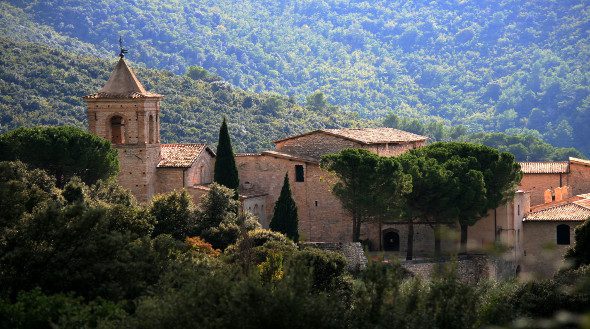
Qualche cenno alla storia dell’Abbazia
Sebbene si abbiamo poche notizie sull’origine del monastero, pare che fu fondato nella seconda metà del secolo XI secolo dai frati benedettini della zona. La costruzione venne basata su una preesistente residenza fortificata della famiglia nobile dei Monaldi (di origine longobarda), donata al monaco fondatore Mainardo dal proprietario di allora, il conte Ugolino di Uppello.
A questo stesso periodo risalgono anche le Carte di Sassovivo appartenenti all’Archivio di Sassovivo, oggi conservato presso l’archivio Arcivescovile di Spoleto: una serie di documenti importanti per la ricostruzione della consistenza territoriale e demografica dell’epoca.
La comunità monastica acquisì presto un vasto patrimonio ed ebbe l’appoggio del papato che, a partire dal 1138, la esentò dalla giurisdizione vescovile e dal pagamento delle tasse ai Comuni. All’inizio del ‘200, dipendevano da Sassovivo ben 92 monasteri, 41 chiese e 7 ospedali. Nella seconda metà del ‘400, passata ai Benedettini olivetani, l’abbazia cominciò a decadere e nel 1860 fu poi soppressa e demanializzata.
Dopo essere stata sede estiva di un seminario vescovile, per un certo periodo a metà anni ’50 l’edificio tornò a pieno regime dando ospitalità ad una piccola comunità di 5 monaci benedettini provenienti dalla Cecoslovacchia. Dal 1979, l’abbazia ospita infine la comunità “Jesus Caritas” ispirata al monachesimo di frontiera del missionario Foucauld, che alterna i servizi pastorali alla manutenzione e alla cura del luogo. Inizialmente, i frati erano affiancati anche dalle “Piccole Sorelle” della medesima comunità, trasferite però in un secondo momento. Ad oggi, quella di Sassovivo è la sede del priorato generale della comunità stessa.
Nella giornata del 14 settembre, si celebra la dedicazione dell’abbazia alla Santa Croce.
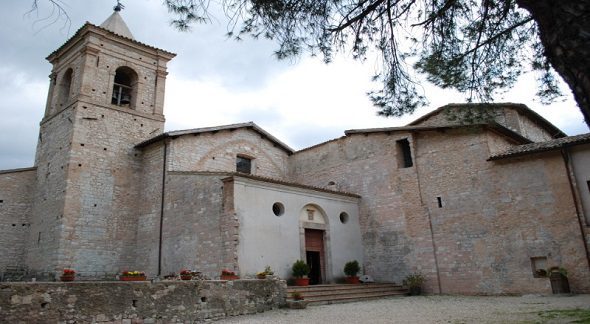
>> Vuoi visitare l’Abbazia di Sassovivo? Contatta ora i migliori agriturismi di Foligno e scopri le offerte!
Visitare l’Abbazia di Sassovivo – Foligno
Dal cortile superiore si entra nella Chiesa, ricostruita dopo il terremoto del 1832 ed in fase di ultimazione di restauro dopo il sisma del 1997.
Dall’atrio che precede la chiesa, una porticina conduce al bellissimo chiostro romanico, opera del maestro romano Pietro de Maria. A pianta rettangolare e interamente in marmo bianco, il chiostro è costituito da un doppio ordine di 128 colonnine abbinate, in parte lisce e in parte a spirale, le quali sostengono 58 archi a tutto sesto e una trabeazione classica con marmi colorati e due liste di mosaici decorati. Solo nel 1314 su un lato vennero inseriti degli archetti gotici decorativi in terracotta.
All’interno del monastero, cui si accede dal chiostro, si possono ammirare pregevoli affreschi, tra i quali ricordiamo, nel refettorio, una Ultima cena, opera di un pittore di cultura tardo manieristica di fine Cinquecento, un San Michele Arcangelo, sopra l’ingresso del refettorio stesso, e una Vergine col Bambino, sopra l’ingresso dell’appartamento dell’abate (sembrerebbe che le ultime due opere siano attribuibili a Tommaso Nasini, artista senese autore della pala d’altare probabilmente del 1744 per la chiesa abbaziale, raffigurante L’annuncio della Passione).
Attraverso i dormitori voltati, di origine duecentesca, si discende alla cosiddetta loggia del Paradiso, che presenta frammenti di affreschi monocromi dei primi del Quattrocento, attribuibili a Giovanni di Corraduccio.
Proseguendo, si avrà modo di raggiungere una seconda loggia, costruita nel 1442, attraverso il riutilizzo di strutture di epoca medievale collocate a protezione di una cripta dell’XI secolo, detta Cappella del beato Alano, residuo di S. Maria del Vecchio (o della Valle), che fu il primo nucleo di Sassovivo. La cripta, riscoperta da pochi anni, venne ricavata da antichi locali venuti alla luce durante i lavori di restauro seguenti il sisma del 1997. Essa è stata consacrata nel 2001 e dedicata a San Marone, eremita siriaco, la cui reliquia, venerata per secoli in abbazia, è stata restituita ai maroniti in occasione del Giubileo del 2000.
Poco distante un’antica fonte e alcuni sentieri che che è possibile percorrere per inoltrarsi all’interno della lecceta secolare che si stende sotto il complesso.
Di seguito, una piccola gallery di foto che ritraggono il Chiostro dell”Abbazia di Sassovivo:
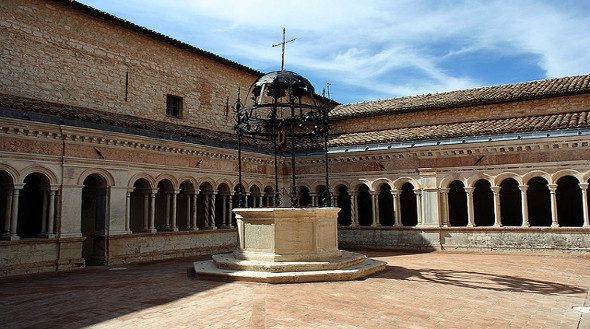
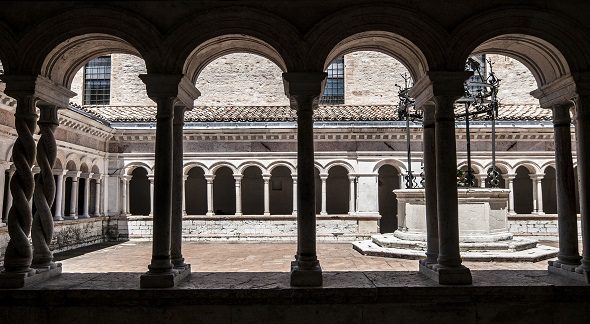
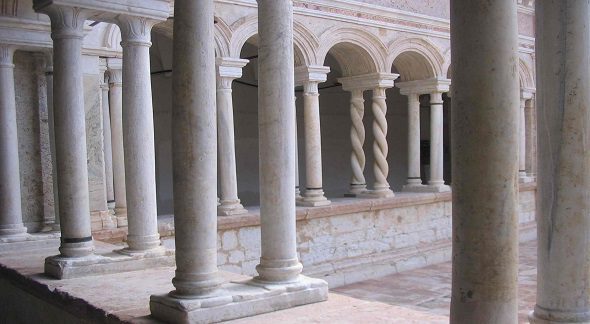
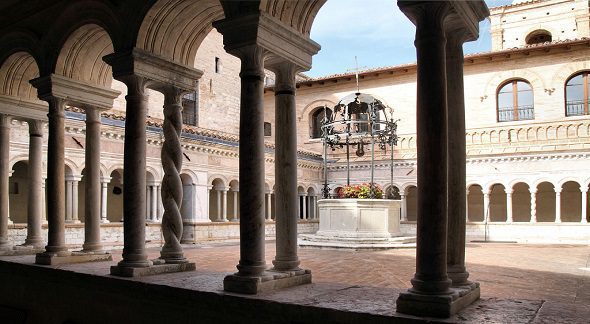
>> Ci sono offerte in scadenza: consulta la lista dei migliori hotel nella zona di Foligno
Just 6 kilometers from Foligno, set in the idyllic natural landscape, is the Sassovivo Abbey, founded in the second half of the eleventh century by Benedictine monks.
>> Do you want to visit the Sassovivo Abbey? Contact now the best farmhouse in Foligno and discover their offers!

The abbey was founded by the Benedictines around 1070, probably by one Mainhard coming from Santa Maria di Sitria. The abbey was based on an existing castle of the Monaldi family, on a site probably used in ancient times by the Umbri as sanctuary.
The abbey soon increased its power and prestige thanks to numerous donations. It also had the support of the Pope who, as of 1138, exempted from the jurisdiction of the bishop and the payment of taxes to municipalities. At the beginning of ‘200, depended on Sassovivo 92 monasteries, 41 churches and 7 hospitals.
In the second half of ‘400, passed to the Benedictines Olivetans, the abbey began to decline and in 1860 it was suppressed.
In the 1970s-1990s a substantial program of restoration was carried on. The church is still under restoration after having been damaged by an earthquake in 1997.
Points of interest include:
– the Romanesque cloister (1229), commissioned by abbot Angelo and executed by the Roman stonemason Pietro de Maria. it has a rectangular plan with 58 arcades supported by a double order of 128 small helicoidal columns with capitals having lily decorations and mosaic tassels. In 1340 a large central cistern was added, followed by a pit in 1623. The cloister is also home to a fresco depicting the Virgin Enthroned with Child (14th century).
– the monastery, with a fresco of the Last Supper (1595) and the 13th century dormitories.
– Loggia del Paradiso, with fragments of 15th-century frescoes.
– Crypt of the Blessed Alano (11th century), a remain of Santa Maria in Valle, the first nucleus of the Sassovivo Abbey.
– Passeggiata dell’Abate (“Abbot’s Walk”), a path within woods of oaks, junipers and Aleppo pines.
>> There are offers in deadline! Click and consult list of the best hotels in Foligno!
![]()
In 1979, the Bishop of Foligno entrusted the Abbey to the Community of “Little Brothers of Jesus Caritas of Father Charles de Foucauld” who are still living there to this day.
>>If you’ve decided to see Foligno and to visit the Sassovivo Abbey you should contact now houses in its vicinity >>click this link
Just 6 kilometers from Foligno, set in the idyllic natural landscape, is the Sassovivo Abbey, founded in the second half of the eleventh century by Benedictine monks.
>> Do you want to visit the Sassovivo Abbey? Contact now the best farmhouse in Foligno and discover their offers!
![]()
The abbey was founded by the Benedictines around 1070, probably by one Mainhard coming from Santa Maria di Sitria. The abbey was based on an existing castle of the Monaldi family, on a site probably used in ancient times by the Umbri as sanctuary.
The abbey soon increased its power and prestige thanks to numerous donations. It also had the support of the Pope who, as of 1138, exempted from the jurisdiction of the bishop and the payment of taxes to municipalities. At the beginning of ‘200, depended on Sassovivo 92 monasteries, 41 churches and 7 hospitals.
In the second half of ‘400, passed to the Benedictines Olivetans, the abbey began to decline and in 1860 it was suppressed.
In the 1970s-1990s a substantial program of restoration was carried on. The church is still under restoration after having been damaged by an earthquake in 1997.
Points of interest include:
– the Romanesque cloister (1229), commissioned by abbot Angelo and executed by the Roman stonemason Pietro de Maria. it has a rectangular plan with 58 arcades supported by a double order of 128 small helicoidal columns with capitals having lily decorations and mosaic tassels. In 1340 a large central cistern was added, followed by a pit in 1623. The cloister is also home to a fresco depicting the Virgin Enthroned with Child (14th century).
– the monastery, with a fresco of the Last Supper (1595) and the 13th century dormitories.
– Loggia del Paradiso, with fragments of 15th-century frescoes.
– Crypt of the Blessed Alano (11th century), a remain of Santa Maria in Valle, the first nucleus of the Sassovivo Abbey.
– Passeggiata dell’Abate (“Abbot’s Walk”), a path within woods of oaks, junipers and Aleppo pines.
>> There are offers in deadline! Click and consult list of the best hotels in Foligno!
![]()
In 1979, the Bishop of Foligno entrusted the Abbey to the Community of “Little Brothers of Jesus Caritas of Father Charles de Foucauld” who are still living there to this day.
>>If you’ve decided to see Foligno and to visit the Sassovivo Abbey you should contact now houses in its vicinity >>click this link
Just 6 kilometers from Foligno, set in the idyllic natural landscape, is the Sassovivo Abbey, founded in the second half of the eleventh century by Benedictine monks.
>> Do you want to visit the Sassovivo Abbey? Contact now the best farmhouse in Foligno and discover their offers!
![]()
The abbey was founded by the Benedictines around 1070, probably by one Mainhard coming from Santa Maria di Sitria. The abbey was based on an existing castle of the Monaldi family, on a site probably used in ancient times by the Umbri as sanctuary.
The abbey soon increased its power and prestige thanks to numerous donations. It also had the support of the Pope who, as of 1138, exempted from the jurisdiction of the bishop and the payment of taxes to municipalities. At the beginning of ‘200, depended on Sassovivo 92 monasteries, 41 churches and 7 hospitals.
In the second half of ‘400, passed to the Benedictines Olivetans, the abbey began to decline and in 1860 it was suppressed.
In the 1970s-1990s a substantial program of restoration was carried on. The church is still under restoration after having been damaged by an earthquake in 1997.
Points of interest include:
– the Romanesque cloister (1229), commissioned by abbot Angelo and executed by the Roman stonemason Pietro de Maria. it has a rectangular plan with 58 arcades supported by a double order of 128 small helicoidal columns with capitals having lily decorations and mosaic tassels. In 1340 a large central cistern was added, followed by a pit in 1623. The cloister is also home to a fresco depicting the Virgin Enthroned with Child (14th century).
– the monastery, with a fresco of the Last Supper (1595) and the 13th century dormitories.
– Loggia del Paradiso, with fragments of 15th-century frescoes.
– Crypt of the Blessed Alano (11th century), a remain of Santa Maria in Valle, the first nucleus of the Sassovivo Abbey.
– Passeggiata dell’Abate (“Abbot’s Walk”), a path within woods of oaks, junipers and Aleppo pines.
>> There are offers in deadline! Click and consult list of the best hotels in Foligno!
![]()
In 1979, the Bishop of Foligno entrusted the Abbey to the Community of “Little Brothers of Jesus Caritas of Father Charles de Foucauld” who are still living there to this day.
>>If you’ve decided to see Foligno and to visit the Sassovivo Abbey you should contact now houses in its vicinity >>click this link
Just 6 kilometers from Foligno, set in the idyllic natural landscape, is the Sassovivo Abbey, founded in the second half of the eleventh century by Benedictine monks.
>> Do you want to visit the Sassovivo Abbey? Contact now the best farmhouse in Foligno and discover their offers!
![]()
The abbey was founded by the Benedictines around 1070, probably by one Mainhard coming from Santa Maria di Sitria. The abbey was based on an existing castle of the Monaldi family, on a site probably used in ancient times by the Umbri as sanctuary.
The abbey soon increased its power and prestige thanks to numerous donations. It also had the support of the Pope who, as of 1138, exempted from the jurisdiction of the bishop and the payment of taxes to municipalities. At the beginning of ‘200, depended on Sassovivo 92 monasteries, 41 churches and 7 hospitals.
In the second half of ‘400, passed to the Benedictines Olivetans, the abbey began to decline and in 1860 it was suppressed.
In the 1970s-1990s a substantial program of restoration was carried on. The church is still under restoration after having been damaged by an earthquake in 1997.
Points of interest include:
– the Romanesque cloister (1229), commissioned by abbot Angelo and executed by the Roman stonemason Pietro de Maria. it has a rectangular plan with 58 arcades supported by a double order of 128 small helicoidal columns with capitals having lily decorations and mosaic tassels. In 1340 a large central cistern was added, followed by a pit in 1623. The cloister is also home to a fresco depicting the Virgin Enthroned with Child (14th century).
– the monastery, with a fresco of the Last Supper (1595) and the 13th century dormitories.
– Loggia del Paradiso, with fragments of 15th-century frescoes.
– Crypt of the Blessed Alano (11th century), a remain of Santa Maria in Valle, the first nucleus of the Sassovivo Abbey.
– Passeggiata dell’Abate (“Abbot’s Walk”), a path within woods of oaks, junipers and Aleppo pines.
>> There are offers in deadline! Click and consult list of the best hotels in Foligno!
![]()
In 1979, the Bishop of Foligno entrusted the Abbey to the Community of “Little Brothers of Jesus Caritas of Father Charles de Foucauld” who are still living there to this day.
>>If you’ve decided to see Foligno and to visit the Sassovivo Abbey you should contact now houses in its vicinity >>click this link







Comment (0)